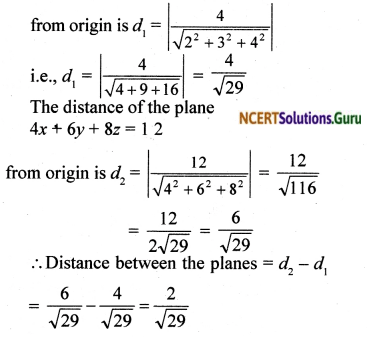NCERT Solutions for Class 12 Maths Chapter 12 Linear Programming Miscellaneous Exercise
These NCERT Solutions for Class 12 Maths Chapter 12 Linear Programming Miscellaneous Exercise Questions and Answers are prepared by our highly skilled subject experts. https://mcq-questions.com/ncert-solutions-for-class-12-maths-chapter-12-miscellaneous-exercise/
NCERT Solutions for Class 12 Maths Chapter 12 Linear Programming Miscellaneous Exercise
![]()
Question 1.
A dietician has to develop a special diet using two foods P and Q. Each packet (containing 30g) of food P contains 12 units of calcium, 4 units of iron, 6 units of cholesterol and 6 units of vitamin A. Each packet of the same quantity of food Q contains 3 units of calcium, 20 units of iron, 4 units of cholesterol and 3 units of vitamin A. The diet requires atleast 240 units of calcium, atleast 460 units of iron and.atmost 300 units of cholesterol. How many packets of each food should be used to maximise the amount of vitamin A in the diet? What is the maxi¬mum amount of vitamin A in the diet?
Solution:
Let x and y be the number of packets of food P and Q. We have the data as
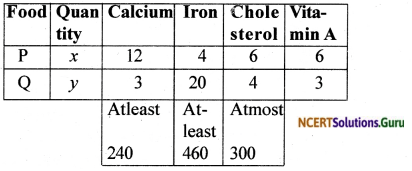
Calcium constraint: 12x + 3y ≥ 240
i.e., 4x + y ≥ 80
Iron constraint: 4x + 20y ≥ 460
i.e., x + 5y ≥ 115
Cholesterol constraint: 6x + 4y ≤ 300
i.e., 3x + 2y ≤ 150
Quantity of vitamin A in the diet Z = 6x + 3y
The LPP is Minimise Z = 6x + 3y
subject to the constraints
4x + y ≥ 80
x + 5y ≥ 115
3x + 2y ≤ 150
x ≥ 0, y ≥ 0
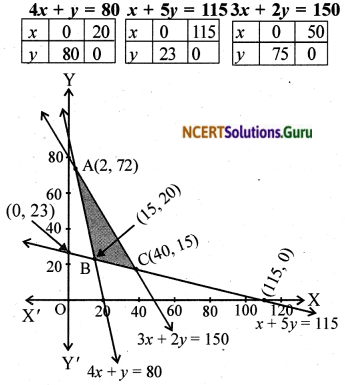
The feasible region is shaded in the figure. We use corner point method to find the minimum value of Z.

Minimum value of Z is at B (15,20). Hence, the amount of vitamin A under constraints given in the problem will be minimum, if 15 packets of food P and 20 packets of food Q are used in the special diet. The minimum quantity of vitamin A will be 15 0 units.
∴ Maximum value of Z is 285 at C(40, 15).
Hence 40 packets of food P and 15 packets of food Q should be used to maximise the amount of vitamin A. The maximum amount of vitamin A in the diet is 285 units.
Question 2.
A farmer mixes two brands P and Q of cattle feed. Brand P, costing ₹ 250 per bag, contains 3 units of nutritional element A, 2.5 units of element B and 2 units of element C. Brand Q costing ₹ 200 per bag, contains 1.5 units of nutritional element A, 1.25 units of element B, and 3 units of element C. The minimum requirements of nutrients A, B and C are 18 units, 45 units and 24 units respectively. Determine the number of bags of each brand which should be mixed in order to produce a mixture having a minimum cost per bag? What is the minimum cost of the mixture per bag?
Solution:
Let x and y denote the number of bags of brand P and brand Q respectively.
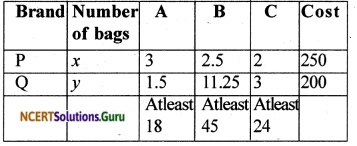
Element A constraint: 3x +1, 5y ≥ 18
Element B constraint: 2.5x + 11.25y ≥ 45
Element C constraint: 2x + 3y ≥ 24
Cost function : Z = 250x + 200y
The L.P.P is minimise Z = 250x + 200y
subject to the constraints 3x + 1.5y ≥ 18, 2.5x + 11.25y ≥ 45, 2x + 3y ≥ 24, x, y ≥ 0.
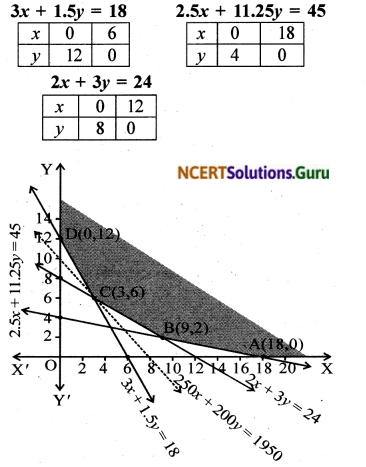
The feasible region is shaded in the figure.

From the table the minimum value of Z is 1950. Since the region is unbounded 1950 may or may not be the minimum value of Z. Consider the inequality 250x + 200y < 1950. This half plane has no point common with the feasible region The minimum value of Z is 1950 at C(3, 6). To produce a mixture having minimum cost, the farmer should mix 3 bags’ of brand P and 6 bags of brand Q.
The minimum cost of the mixture is ₹ 1950
Question 3.
A dietician wishes to mix together two kinds of food X and Y in such a way that the mixture contains atleast 10 units of vitamin A, 12 units of vitamin B and 8 units of vitamin C. The vitamin contents of one kg food is given below:

One kg of food X costs Rs. 16 and one kg of food Y costs Rs.20. Find the least cost of the mixture which will produce the required diet.
Solution:
Let x kg of food X and y kg of food Y be mixed in the diet. We have the data as

Vitamin A constraint: x + 2y ≥ 10
Vitamin B constraint: 2x + 2y ≥ 12
Vitamin C constraint: 3x + y ≥ 18
Cost function Z = 16x + 20y
The L.P.P. is
Minimise Z = 16x + 20y
subject to the constraints
x + 2y ≥ 10, 2x + 2y ≥ 12, 3x + y ≥ 8, x, y ≥ 0

From the table, the minimum value of Z is 112. Since the region is unbounded 112 may or may not be the minimum value of Z. Consider the inequality 16x + 20y =112. This half plane has no point common with the feasible region.
∴ Minimum value of Z is 112 at B(2, 4). Hence 2kg of food X and 4kg of food Y should be mixed. The least cost of the mix-ture is ₹ 112
Question 4.
A manufacturer makes two types of toys A and B. Three machines are needed for this purpose and the time (in minutes) required for each toy on the machines is given be-low:

Each machine is available for a maximum of 6 hours per day. If the profit on each toy of type A is ₹ 7.50 and that on each toy of type B is ₹ 5, show that 15 toys of type A and 30 of type B should be manufactured in a day to get maximum profit.
Solution:
Let x be the no. of toys of type A and y be the no. of toys of type B.
We have the data as

Machine I constraint: 12x + 6y ≤ 360
Machine II constraint: 18x ≤ 360
Machine II constraint: 6x + 9y ≤ 360
Profit function : Z = 7.5 x + 5y
The LPP is maximise Z = 7.5 x + 5y
subject to the constraints 12x + 6y ≤ 360, 18x + 0y ≤ 360, 6x + 9y ≤ 360, x, y ≥ 0.
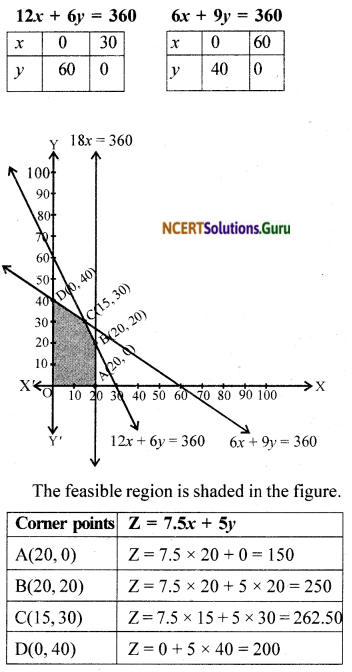
∴ Maximum value of Z is 262.50 at C(15, 30).
Hence 15 toys of type A and 30 toys of type B should be manufactured in a day to get maximum profit.
Question 5.
An aeroplane can carry a maximum of 200 passengers. A profit of ₹ 1000 is made on each executive class ticket and a profit of ₹ 600 is made on each economy class ticket. The airline reserves atleast 20 seats for executive class. However, atleast 4 times as many passengers prefer to travel by economy class than by the executive class. Determine how many tickets of each type must be sold in order to maximise the profit for the airline. What is the maximum profit?
Solution:
Let x tickets of executive class and y tickets of economy class be sold.
We have the data as
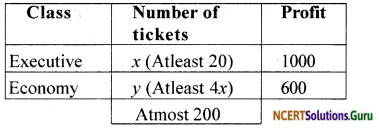
Total ticket constraint: x + y ≤ 200
Executive ticket constraint: x ≥ 20
Economy ticket constraint: y ≥ Ax
Profit function : Z = 1000x + 600y
The L.P.P. is maximise Z = 1000x + 600y
subject to the constraints x + y ≤ 200, x ≥ 20, y ≥ 4x, x, y ≥ 0.

The feasible region is shaded in the figure.
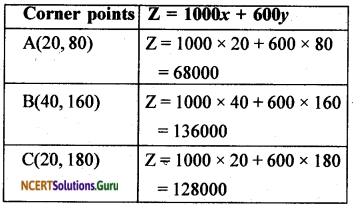
Hence 40 tickets of executive class and 160 tickets of economy class are to be sold to get the maximum profit. The maximum profit is ₹ 136000
Question 6.
Two godowns A and B have grain capacity of 100 quintals and 50 quintals respectively. They supply to 3 ration shops, D, E and F whose requirements are 60,50 and 40 quintals respectively. The cost of transportation per quintal from the godowns to the shops are given in the following table:
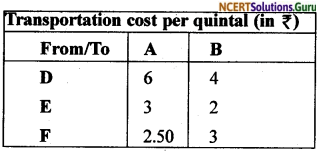
How should the supplies be transported in order that the transportation cost is minimum? What is the minimum cost?
Solution:
Let x quintals of grains are transported from godown Ato ration shop D andy quintals be transported from godown Ato ration shop E.
We have the data as

The transported quantity of rice is non negative x ≥ 0, y ≥ 0, 100 – (x + y) ≥ 0, 60 – x ≥ 0
50 – y ≥ 0 , x + y – 60 ≥ 0
i.e., x + y ≤ 100, x + y ≥ 60, x ≤ 60, y ≤ 50, x ≥ 0, y ≥ 0
The total transportation cost
Z = 6x + 3y + 2.5 (100 – (x + y) + 4(60 – x) + 2(50 – y) + 3 (x + y – 60)
Z = 2.5x + 1.5y + 410
The L.P.P. is Minimise Z = 2.5x + 1.5y + 410
subject to the constraints x ≤ 60, y ≤ 50, x + y ≥ 60, x + y ≤ 100, x, y ≥ 0

The minimum value of Z is 510 at D( 10,50)
Hence the supply from godown A are 10,50,40 quintals and from godown B are 50,0,0 quintals to shops D, E and F respectively and the minimum cost is ₹ 510
Question 7.
An oil company has two depots A and B with capacities of 7000 L and 4000 L respectively. The company is to supply oil to three petrol pumps, D, E and F whose requirements are 4500L, 3000L and 3500 L respectively. The distances (in km) between the depots and the petrol pumps is given in the following table:
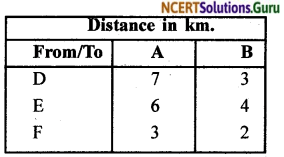
Assuming that the transportation cost of 10 litres of oil is ₹ 1 per km, how should the delivery be scheduled in order that the transportation cost is minimum? What is the minimum cost?
Solution:
Let x litre of oil be supplied from depot A to pump D and y litre of oil from depot B to pumb E. Then 7000 – (x + y) litre of oil will be transported to pump F.
The oil supplied from B to D, E and F are 4500 – x, 3000 – y, x + y – 3500
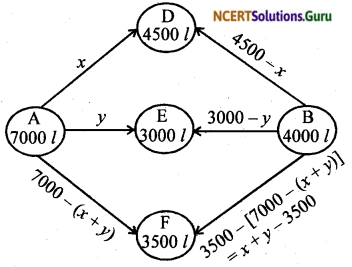
The transportation cost of 10 litres of oil for 1 km is ₹ 1.
∴ Transportation cost
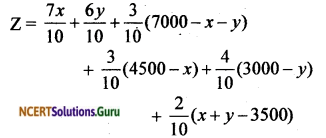
Z = 0.3 x + 0.1 y + 3950
The transported quantity of oil is non negative.
i.e., x ≥ 0, y ≥ 0, 7000 – (x + y) ≥ 0
4500 – x ≥ 0, 3000 – y ≥0, x + y – 3500 ≥ 0
i.e., x, y ≥ 0
x + y ≤ 7000
x + y ≥ 3500
x ≤ 4500
y ≤ 3000
Hence the L.P.P. is
Minimise Z = 0.3x + 0. 1 y + 3950 subject to the constraints x ≤ 4500, y ≤ 3000, x + y ≤ 7000, x + y ≥ 3500, x, y ≥ 0
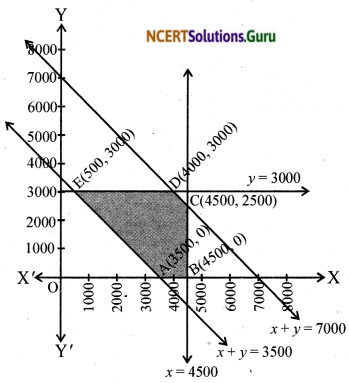
The feasible region is shaded in the figure. We use comer point method to find the minimum value of Z.
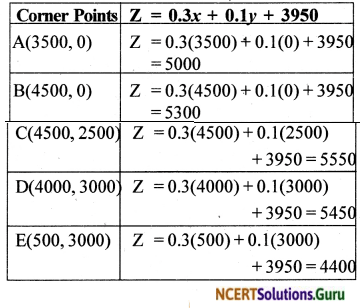
The minimum of Z is 4400 at E (500, 3000)
When x = 500 and y = 3000 500 l, 3000 l, 3500 l of oil should be trans¬ported from depot A to pumps D, E and F and 4000 l, 0 l, 0 l are transported from B to pumps D, E and F
Question 8.
A fruit grower can use two types of fertilizer in his garden, brand P and brand Q. The amounts (in kg) of nitrogen, phosphoric acid, potash, and chlorine in a bag of each brand are given in the table. Tests indicate that the garden needs atleast 240 kg of phosphoric acid, atleast 270 kg of potash and atmost 310 kg of chlorine.
If the grower wants to minimise the amount of nitrogen added to the garden, how many bags of each brand should be used? What is the minimum amount of nitrogen added in the garden?

Solution:
Let x bags of brand P and y bags of brand Q be used in the garden.
We have the data as
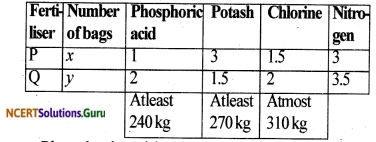
Phosphoric acid constraint: x + 2y ≥ 240
Potash constraint: 3x + 1.5y ≥ 270
Chlorine constraint: 1.5x + 2y ≤ 310
Quantity of nitrogen : Z = 3x + 3.5y
The L.P.P. is Minimise Z = 3x + 3.5y
subject to the constraints x + 2y ≥ 240, 3x + 1.5y ≥ 270, 1.5x + 2y ≤ 310, x, y ≥ 0.
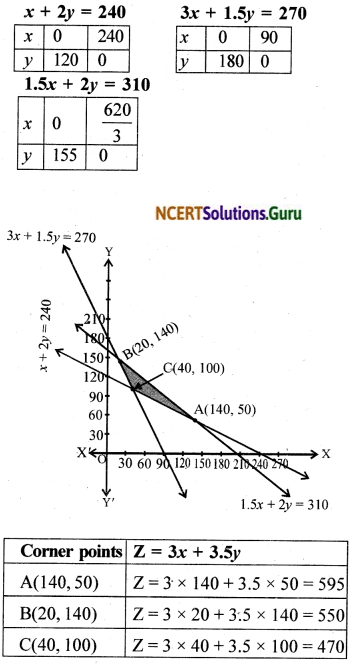
The feasible region is shaded in the figure.
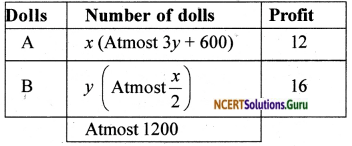
∴ Minimum value of Z is 470 at C(40, 100)
Hence 40 bags of brand P and 100 bags of brand Q are used.
The minimum amount of nitrogen is 470.
Question 9.
A fruit grower can use two types of fertilizer in his garden, brand P and brand Q. The amounts (in kg) of nitrogen, phosphoric acid, potash, and chlorine in a bag of each brand are given in the table. Tests indicate that the garden needs atleast 240 kg of phos-phoric acid, atleast 270 kg of potash and atmost 310 kg of chlorine. If the grower wants to maximise the amount of nitrogen added to the garden, how many bags of each brand should be added? What is the maximum amount of nitrogen added?
Solution:
Let x bags of brand P and y bags of brand Q be used in the garden.
We have the data as

Phosphoric acid constraint: x + 2y ≥ 240
Potash constraint: 3x + 1.5y ≥ 270
Chlorine constraint: 1.5x + 2y ≤ 310
Quantity of nitrogen : Z = 3x + 3.5y
The L.P.P. is Minimise Z = 3x + 3.5y
subject to the constraints x + 2y ≥ 240, 3x + 1.5y ≥ 270, 1.5x + 2y ≤ 310, x, y ≥ 0.

The feasible region is shaded in the figure.

The maximum value of Z is 595 obtained at A(140,50)
Hence 140 bags of brand P and 50 bags of brand Q are used.
The maximum amount of nitrogen is 595.
Question 10.
A toy company manufactures two types of dolls, A and B. Market tests and available resources have indicated that the combined production level should not exceed 1200 dolls per week and the demand for dolls of type B is utmost half of that for dolls of type A. Further, the production level of dolls of type A can exceed three times the production of dolls of other type by utmost 600 units. If the company makes profit of ₹ 12 and ₹ 16 per doll respectively on dolls A and B, how many of each should be produced weekly in order to maximise the profit?
Solution:
Let the number of dolls of type A be x and that of type B be y.
We have the data as

Total dolls constraint: x + y ≤ 1200
Doll A constraint: x ≤ 3y + 600 or x – 3y ≤ 600
Profit function : Z = 12x +16y
The L.P.P is maximise Z = 12x + 16y
subject to the constraints
x + y ≤ 1200, x – 3y ≤ 600, y ≤ \(\frac { x }{ 2 }\), x ≥ 0, y ≥ 0
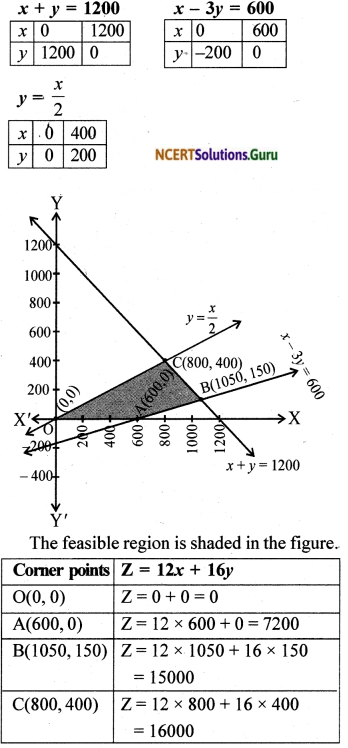
The maximum value of Z is 16000 at C(800,400) Hence 800 dolls of type A and 400 dolls of type B should be manufactured to get maximum profit.
The maximum profit is ₹ 16000.
NCERT Solutions for Class 12 Maths Chapter 12 Linear Programming Miscellaneous Exercise Read More »


































